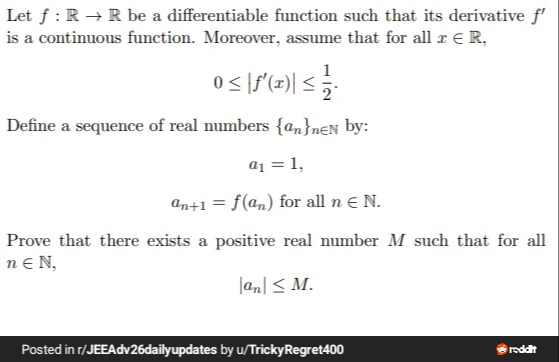Question
Question: Let $f: \mathbb{R} \rightarrow \mathbb{R}$ be a differentiable function such that its derivative $f'...
Let f:R→R be a differentiable function such that its derivative f′ is a continuous function. Moreover, assume that for all x∈R,
0≤∣f′(x)∣≤21.Define a sequence of real numbers {an}n∈N by:
a1=1, an+1=f(an) for all n∈N.Prove that there exists a positive real number M such that for all n∈N,
∣an∣≤M.
The sequence {an} is bounded. There exists a positive real number M such that for all n∈N, ∣an∣≤M. A possible value for M is 1+2∣f(1)−1∣.
Solution
The condition 0≤∣f′(x)∣≤21 implies that f is a Lipschitz function with a Lipschitz constant L=21. By the Mean Value Theorem, for any two distinct real numbers u and v, there exists a c between u and v such that f(u)−f(v)=f′(c)(u−v). Taking the absolute value, we get ∣f(u)−f(v)∣=∣f′(c)∣∣u−v∣. Since ∣f′(c)∣≤21, we have ∣f(u)−f(v)∣≤21∣u−v∣ for all u,v∈R.
Applying this to consecutive terms of the sequence: ∣an+1−an∣=∣f(an)−f(an−1)∣≤21∣an−an−1∣ for n≥2. Let C=∣a2−a1∣=∣f(a1)−a1∣=∣f(1)−1∣. Then, ∣ak+1−ak∣≤C(21)k−1 for k≥1.
We can express an as a telescoping sum: an=a1+∑k=1n−1(ak+1−ak) for n≥2. Using the triangle inequality: ∣an∣≤∣a1∣+∑k=1n−1∣ak+1−ak∣≤1+∑k=1n−1C(21)k−1.
The sum is a finite geometric series: ∑k=1n−1C(21)k−1=C∑j=0n−2(21)j=C⋅1−1/21−(1/2)n−1=2C(1−(21)n−1).
Thus, for n≥2: ∣an∣≤1+2C(1−(21)n−1). Since 1−(1/2)n−1<1, we have ∣an∣<1+2C. For n=1, ∣a1∣=1, which is also ≤1+2C as C≥0. Therefore, for all n∈N, ∣an∣≤1+2C=1+2∣f(1)−1∣. Let M=1+2∣f(1)−1∣. Since f(1) is a real number, M is a positive real number. This proves that the sequence {an} is bounded.
